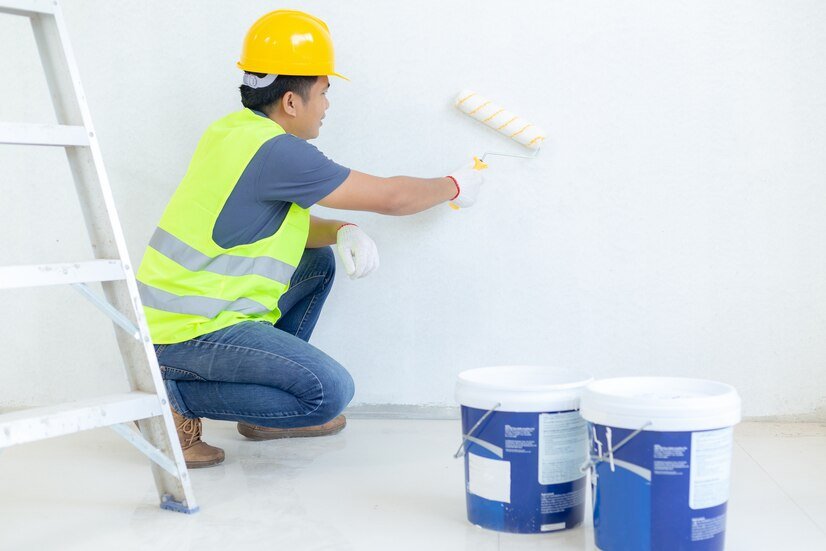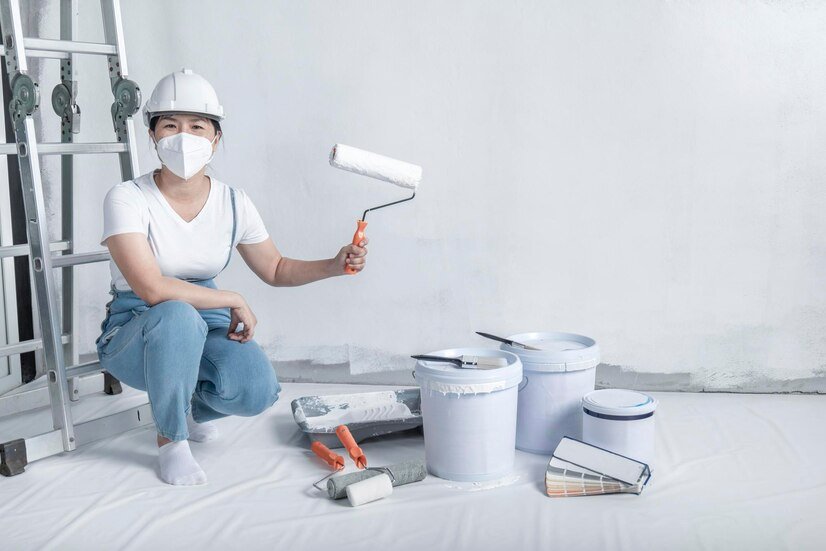Room painting is one of the simplest ways to rejuvenate the look and feel of your home. Whether aiming to brighten up a drab space or add a splash of personality, mastering the art of room painting can significantly impact. Choosing the right colors and techniques can transform any room into a more inviting and stylish environment.
This guide will walk you through essential room painting tips that ensure a fresh new look while maximizing your paint job’s effectiveness. From prep work to selecting the perfect finish, these room painting insights will help you achieve a professional result and breathe new life into your living space.

Choosing the Right Paint Color for Your Room
Choosing the right paint color for your room can significantly influence its ambiance and overall appeal. The perfect color enhances the space and reflects your personal style.
- Consider the Room’s Purpose: Choose colors that align with the room’s function. Soft hues like blues and greens are great for bedrooms, while bright shades can energize a living area.
- Account for Lighting: Natural and artificial light can alter how paint colors appear. Test samples in different lighting conditions to see how they look throughout the day.
- Match with Existing Decor: Ensure the paint color complements your existing furniture and decor. Select shades that harmonize with the overall theme of your room.
- Think About Room Size: Light colors can make small rooms feel more prominent, while darker shades add warmth and intimacy to spacious areas. Choose accordingly based on your room size.
- Test Before Committing: Apply paint samples on your walls to observe how the color looks in your space. This helps prevent costly mistakes and ensures satisfaction with the final choice.
Preparing Your Room for Painting
Proper preparation is key to a successful painting project and can significantly impact the outcome. Begin by thoroughly cleaning the walls to remove dust, dirt, and grease, which can interfere with paint adhesion. Next, address any imperfections by filling holes and cracks with an appropriate filler, then sand the surface smooth once it’s dry to ensure an even application.
To protect your flooring and furniture, cover them with drop cloths or plastic sheeting to avoid paint splatters and spills. Remove any hardware, light fixtures, and outlet covers to prevent them from getting painted over. Use painter’s tape to mask off edges, trim, and adjacent areas for clean, sharp lines. This thorough preparation ensures a smoother paint application and a more professional finish, enhancing the overall look and longevity of your room’s new paint job.
Essential Tools and Supplies for Room Painting
The right tools and supplies are crucial for achieving a professional-looking paint job and ensuring a smooth process. Essential tools include high-quality brushes and rollers, which help apply paint evenly and reduce streaks for a flawless finish. Invest in painter’s tape to achieve clean, crisp edges around trim and corners. A paint extender can make your job easier by increasing paint coverage and reducing application effort.
Selecting a good-quality primer is important, especially when covering dark colors or stains, as it ensures better coverage and adhesion. A sturdy ladder is essential for reaching high areas safely, while a paint can opener and stirrer help prepare and mix the paint. Using these high-quality supplies not only improves the final look but also streamlines the painting process, saving you time and effort.
Techniques for a Smooth Paint Application
Achieving a flawless paint job requires mastering a few essential techniques. By applying these methods, you’ll ensure a smooth, even finish with minimal imperfections.
- Use Quality Brushes and Rollers: Invest in high-quality brushes and rollers for a smoother application. They help distribute the paint evenly and reduce streaks, ensuring a professional finish.
- Apply Thin Coats: Apply multiple thin coats rather than one thick coat. Thin layers dry more evenly and prevent drips and runs, leading to a more uniform surface.
- Follow a ‘W’ Pattern: When using a roller, apply paint in a ‘W’ pattern. This technique helps distribute paint more evenly, minimizing roller marks for a smooth finish.
- Maintain a Wet Edge: Always maintain a wet edge while painting to avoid lap marks. Overlap each section slightly before the previous area dries to ensure a seamless blend.
- Allow Adequate Drying Time: Let each coat dry completely before applying the next one. Proper drying between coats ensures better adhesion and a smoother final appearance.
Understanding Different Paint Finishes
Paint finishes significantly impact the look and durability of your painted surfaces. Matte finishes offer a non-reflective surface and are ideal for hiding imperfections, making them suitable for low-traffic areas. Satin finishes provide a soft sheen and are more durable, making them a good choice for areas that require some washability, such as living rooms.
Semi-gloss finishes are more reflective and are often used in high-traffic areas or for trim and moldings, as they can withstand cleaning and resist moisture. Gloss finishes are the most reflective and are usually reserved for accent pieces or high-impact areas where a high shine is desired. Choosing the right finish ensures both aesthetic appeal and practicality in your room.
Creating Accent Walls with Paint
Accent walls are a great way to add visual interest and personality to a room. Start by choosing a wall that will serve as the room’s focal point, such as one behind the main piece of furniture or a wall that contrasts with the other walls. Select a color or pattern that complements your decor and adds a striking contrast.
Techniques for creating accent walls include using bold colors, geometric patterns, or even textured paint. Proper preparation and use of painter’s tape are essential to ensure clean lines. An accent wall can dramatically enhance the room’s appearance and create a unique feature without overwhelming the space.
The Role of Primer in Room Painting
Primer is an important step in the painting process, providing a foundation that ensures better paint adhesion and durability. It helps to seal the surface, which can be particularly useful if you’re painting over new drywall or a surface with stains or dark colors. Primer also helps to improve the coverage of the topcoat, reducing the number of paint layers needed and saving time and money.
Additionally, it can enhance the paint’s actual color by creating a uniform base. Choose the suitable primer for your surface type—oil-based for stains and sealers or latex-based for drywall and other porous surfaces—to achieve the best results in your painting project.
Post-Painting Care and Maintenance
Proper post-painting care is essential to maintain the quality and appearance of your newly painted surfaces. These simple steps will help keep your paint job fresh and pristine.
- Wait Before Cleaning: Allow the paint to fully cure before cleaning. This ensures the paint has been appropriately set and prevents smudging or damage.
- Use Mild Detergent: Clean walls with a soft cloth and mild detergent to avoid harsh chemicals that could damage the paint. This helps maintain the paint’s finish and color.
- Avoid abrasive materials or scrubbing too hard, as they can scratch or wear down the paint. Gentle cleaning preserves the paint’s integrity.
- Address Touch-Ups Promptly: Fix any marks or scuffs as soon as they appear to avoid more significant repairs later. Matching the paint color and finish ensures seamless touch-ups.
- Maintain Room Conditions: Keep the room’s temperature and humidity levels stable to avoid issues like peeling or cracking. Proper conditions support the longevity of your paint job.
Color Trends for Modern Room Painting
Staying informed about color trends is essential for making stylish and up-to-date choices when painting your room. Modern trends often feature soothing neutrals, bold jewel tones, and earthy hues that create welcoming and fashionable spaces. Consider incorporating colors that reflect your taste and align with current design trends, such as calming blues, rich greens, or warm terracottas for a contemporary look.
Accent colors and dynamic combinations can add a fresh twist to your decor, enhancing the room’s visual appeal. While trends inspire, it is crucial to select shades that complement your style and existing decor. This approach ensures a balanced, cohesive design that remains timeless and aesthetically pleasing.
Budgeting for a Room Painting Project
Budgeting effectively for a room painting project requires detailed planning and cost estimation. Begin by measuring the room to determine the amount of paint required and calculate the cost of essential supplies, such as paint, primer, brushes, rollers, and painter’s tape. Include potential expenses for professional help if needed, and explore options for sales or bulk discounts to reduce costs.
Remember to account for additional expenses, such as repair materials to fix wall imperfections or specialty finishes for a unique look. Setting a realistic budget and tracking your spending ensures you have all the necessary supplies and services, helping you achieve a high-quality paint job without overspending. Careful budgeting makes the process smoother and more cost-effective.
Refreshing your home with a new paint job can completely transform your living space, adding personality and style. You can ensure a smooth and professional finish by selecting the right colors, preparing your room correctly, and using effective techniques. Whether you’re aiming for a subtle update or a bold new look, the tips will help you make informed decisions and achieve the desired result.
Ready to give your home a fresh new look? Contact Full Coverage Painting today for expert room painting services. Based in Vacaville, CA, our team is dedicated to delivering high-quality results. Call or text us at 707-384-5108 to schedule your consultation and start your painting project.







